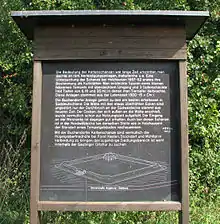Viereckschanze
A Viereckschanze (from German "four-corner-rampart"; plural -en) is a rectangular ditched enclosure that was constructed during the Iron Age in parts of Celtic Western Europe. They are widespread in Germany, parts of northern France[1][2] and also in some regions of the Iberian Peninsula, most notably in Portugal.[3]

Drawing of the Viereckschanze Buchendorf in Germany
See also
References
- Cunliffe, Barry (1997). The Ancient Celts. Oxford and New York: Oxford University Press; pp. 200-201.
- Koch, John T. (2006). Celtic Culture: A Historical Encyclopedia. 1. ABC-CLIO. p. 229. ISBN 978-1-85109-440-0. Retrieved 7 January 2015.
Plan of the densely-occupied Bopfingen: the 2nd-century BC Viereckschanze (83 m x 73 m) is at the bottom, a 9.5 x 10 m building lies inside the Viereckschanze to the lower left, and two other buildings are visible as large post holes at opposite ...
- https://www.academia.edu/310734/La_contribution_de_la_prospection_g%C3%A9omagn%C3%A9tique_pour_la_compr%C3%A9hension_de_la_pal%C3%A9oforme_de_Matabodes_Beja_Portugal_
This article is issued from Wikipedia. The text is licensed under Creative Commons - Attribution - Sharealike. Additional terms may apply for the media files.